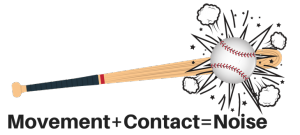How to Solve Any Noise Problem
Today we’re going to talk about noise problems. (A topic you’re VERY familiar with if you happen to be a parent…) Whether you’re dealing with a wind noise, a squeak, a creak, a hum, a buzz, or a tizzle, you’ll find that ALL noise problems have 2 things in common.
What Makes a Noise?
Noise problems are always the result of:
- Contact and
- Movement
YOUR JOB is to find where the contact is and what is moving.
[bctt tweet=”Noise problems always have 2 things in common – they are always the result of Contact and Movement.”” username=”@lightningsolve”]
Are You Sure that’s IT? Sounds so Simple!
Here are a few quick pointers on things to observe while you dig for the culprit.
First, compare the non-noisy parts. Check to see if they have contact or movement or what they are lacking.
- Do they have movement but no contact? -OR-
- Do they have contact with no movement?
- Maybe the “good” parts are actually noisy but you just can’t hear it for some reason?
Watch me Solve THIS Tricky One
I once had a shifter noise where if you held your hand in front of the part it acted as a megaphone and you could hear the noise. But the people who drove with their hands over the shifter couldn’t hear the noise. Knowing the right questions to ask, I was able to find root cause within hours – after the engineer had worked that project for weeks!
This information I’m giving you might sound simple, but it’s so valuable for finding the root of your noise problems lightning fast!
[bctt tweet=”“Knowing the right questions to ask, I was able to find root cause within hours – after the engineer had worked that project for weeks!”” username=”@lightningsolve”]
But I’ve Already Tried Keeping it Simple!
 Sometimes it is complicated to find the contact and movement. So here are a few tips to help you get to the bottom of your noisy nuisance:
Sometimes it is complicated to find the contact and movement. So here are a few tips to help you get to the bottom of your noisy nuisance:
- There might be parts you need to cut away to see what’s underneath.
- You might need to use chassis ears or a stethoscope with a tube to hear specific points of the parts.
- Another thing you can do is to put accelerometers on the part to check for movement.
- Usually it’s best to record the noise to make the noise a variable measurement.
It’s much easier to solve a project if you have a variable measurement system instead of either “noise” or “no noise.
[bctt tweet=”“It’s much easier to solve a project if you have a variable measurement system instead of either “noise” or “no noise”.”” username=”@lightningsolve”]
Now for the Moment of Truth
Once you find the difference between the good parts and the noisy parts, build 3 the bad way and 3 the good way. Run them through a test. If the 3 bad ones are noisy and the 3 good ones are quiet, most likely you have the root cause and your problem is solved!
If you want more tricks of the trade, be sure to watch my video Broken Parts, 5 Steps to Solve FAST!
Thanks for stopping by! Until next time, happy problem solving!
If you have any pointers on solving noise problems lightning fast please feel free to share them in the comments below!








